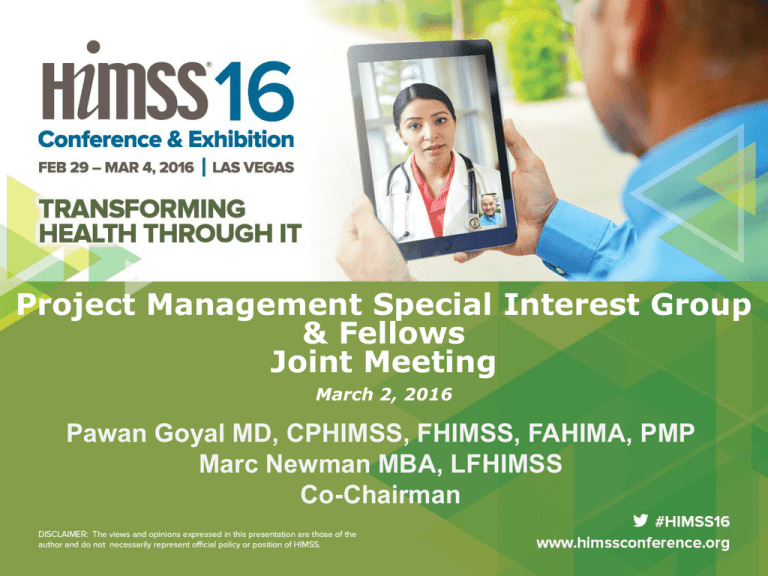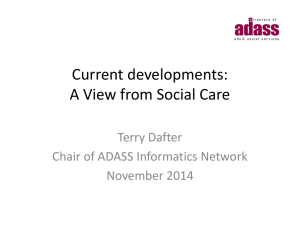Project Management Special Interest Group & Fellows Joint Meeting
advertisement

Project Management Special Interest Group & Fellows Joint Meeting March 2, 2016 Pawan Goyal MD, CPHIMSS, FHIMSS, FAHIMA, PMP Marc Newman MBA, LFHIMSS Co-Chairman Conflict of Interest None of panelists and Co-Chairs have any conflict of interest. Agenda • • • • • • Welcome and introductions Year in Review FY 2016 Goals Panel Discussion Panel Discussion Wrap Up Summary/Discussion Year In Review • Education – 5 Sessions Available • SIG Home Page – Knowledge Base Established New Year Goals • Add new and exciting Webinars to SIG library • Begin collecting materials for a knowledge library • Increase interaction with HIMSS Chapters • Polling to determine the state of PM practices and opportunities for additional education • Increase volunteer participation in the SIG • Re-establish communication with PMI • Increased fellow interactions Learning Objectives • Explore emerging project management issues and lessons learned to implement significant project types: – EHR and PHR implementation – Health Data Interoperability and Exchange – Big Data – Mobile Health, Telehealth – Unified Digital Experience – Revenue Cycle, Administrative Systems What are Some of the Common Themes? Project Lifecycle Plan: Milestones: Tasks: Activities Governance Program Stakeholder Data Security and Privacy Big Data and Knowledge Management Data Information Knowledge Best Practices Learning Organization 7 Panel Discussion • Bo Dagnall Chief Technologist, HP Enterprise and Veterans Affairs • Satish Gattadahalli Manager and Principal Strategist, Health Care Transformation, WBB • Cherie Pardue IT Executive Health Systems Engineering Landscape Systems Engineering and PM Checklist Establish Vision, PMO, Governance, Supporting Collaboratives, Change Mgt., and Secure Leadership Buy-in. Align with Strategy. Develop 2 year Operating Plan, Integrated Master Plan & Schedule, Risk Mgt. Strategy. Launch Enterprise-scale system redesign/process improvement (PI) efforts. Establish PI ambassadors. Develop Reqs. and Cost Foundations: CONOPS, Functional and Detailed Requirements, Usability, Design Thinking/Journey Maps, HFE/Digital Experience, Systems Quality Factors, SLAs. Develop Analyses of Alternatives, Life Cycle Costs, and Prototypes. Develop and Institute Business-driven EA: Business Capabilities, e2e/interrelated processes, Data & Technical Architecture for interoperability, Shared Infrastructure/Services, Modeling & Simulation. Establish enterprise scale analytics platform and data life cycle management practices. 10 Establish Privacy and Security Foundations and Policies (incl. Patient Generated Data, Genomics, Clinical/Wearable Device). Develop Outcomes-based Performance Measures across quality dimensions and enable continuous monitoring & improvement. Implement Agile Development Practices, IPTs. Implement QA, e2e testing, verification, and validation. Institutionalize Governance & Reviews (Architecture, Data Quality, Requirements Management, PMR, Scrum, Patient Safety, Usability, Systems Engg. Reviews, UAT, Performance & Reliability, Independent Reviews/Audits). Launch benefits measurement capability and KM Portal: feedback, lessons learned, impacts, best practices. Publish Data/Open Data: Supply-chain, quality, access, safety, cost, and include industry benchmarks. Establish innovation centers/COEs/network, Employee Idea Bank. Engage with academia and think tanks. Institute Challenge Awards. Establish Communications, Training, and Technical Assistance in Systems Engineering, Methods and Tools for Quality Improvement (e.g., lean training). Analytic Best Practices • Informatics and IM Governance (Steering Committee, Data Governance & Data Quality WG, Security and Privacy WG, Data Stewards & Data Quality Metrics, Quarterly Measures Review)-Backed by Chief Data/Analytic Officer. • Data Strategy (incl. Big Data), Data Principles, Roadmap, Usecases, Requirements, Journey Maps (Design Thinking), Data Ownership. • Analytics built into workflows– point of care, patient engagement/delight. • Demonstrable business value– ACO, PHM, Scheduling/OR Optimization, Modeling Medication Error, etc. • Analytics COE, Analytics and Data Science Training, Enterprise Data Literacy, Outcomes-based rewards and risk sharing, culture alignment. Enterprise Data Architecture • Data Standards, Data Models, Conformed Dimensions, Measures Ratified • Master Data Management, Customer Data Integration, Reference Data, and Standardized Vocabulary • Metadata Management: Shared & Searchable Metadata • Data Quality SLAs (source systems and suppliers), and Data Quality Practices • Alignment with cloud strategy • Data infrastructure leverages SOA, Standards (e.g., FHIR, NIEM, HL7 2x, CCDA), and designed for interoperability & exchange Knowledge Transfer In organizational theory, knowledge transfer is the practical problem of transferring knowledge from one part of the organization to another. Like knowledge management, knowledge transfer seeks to organize, create, capture or distribute knowledge and ensure its availability for future users. It is considered to be more than just a communication problem. en.wikipedia.org/wiki/Knowledge_transfer Tacit or explicit transfer - which works the best? Another great exercise Nick Milton Read more: http://www.nickmilton.com/2009/07/tacit-or-explicit-transfer-whichworks.html#ixzz41DRdcDQP Knowledge Transfer - Ownership • EHR and PHR implementation • Health Data Interoperability and Exchange • Big Data • Mobile Health, Telehealth • Unified Digital Experience • Revenue Cycle, Administrative Systems RTHS Definition A healthcare system that converges data from all available and applicable data sources, analyzes it for key findings, and provides real-time insights to patient and providers. Technology convergence to solve complex business problems “Physicians will make treatment decisions based on the chest pain a patient is experiencing at the moment—from data being delivered real-time via mobile device to provider—rather than from symptoms several days prior reported during an office visit several days later.”1 1 Derek Newell, Four ways real-time data will change healthcare, http://www.ilhitrec.org/ilhitrec/pdf/HIMSS_June2013.pdf Emerging Technology/Data Equipment: smart beds, medication dispensers and compliance monitors, RFID for real-time location tracking, telehealth, bedside monitors, … Nanochips1: tumor detection, tumor DNA appearance, immune activation, genomic signals indicative or heart attack, stroke or cancer, Type 1 diabetes detection, antibody signals, drug tailoring, inflammation detection and location, … Biosensors: BP, heart rhythm, respiratory rate, SO2, heart rate variability, cardiac output, temperature, eye pressure, glucose, brain waves, intracranial pressure, muscle movements, fetal heart rate, sleep metrics, … Mobile imaging: X-ray, CT, nuclear/PET, ultrasound, MRI, … Potential Use Cases Tracking Assets/Resources Tracking People Clinical Data • Broad use cases for tracking nonhuman assets can include: • Patient movement tracking and way-finding • Patient monitoring (either remote or in a care facility) • Locating an asset in a care facility (e.g. “Where is the nearest EKG machine?”) • Clinical staff workflow analysis and optimization • Mobile lab tests • Asset/resource management and scheduling • Guideline and safety compliance such as hand-washing determination • Mobile physical examination • Preventative asset maintenance • Patient elopement • Theft detection • Behavior and movement monitoring (including fall detection) • Environmental monitoring (e.g. Temperature, pressure, humidity, etc. for lab samples.) • Optimized supply utilization • Mobile imaging • Compliance monitoring • Biosurveillance • Infection identification and control, and disease detection. • Exposure to infectious or harmful agents • Supply chain management 2 Questions? Comments? Discussion? Dr. Pawan Goyal, Client Principal, HP Enterprise, pawan.goyal@hpe.com Marc Newman, Consultant marcnewma@gmail.com Satish Gattadahalli, Manager and Principal Strategist, WBB Consulting sgattadahalli@wbbinc.com Bo Dagnall, Chief Technologist, HP Enterprise bo.dagnall@hpe.com Cherie Pardue, IT Executive cpardue@cox.net

